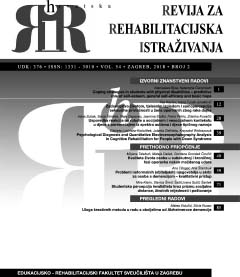Coping strategies in students with physical disabilities – predictive role of self-esteem, general self-efficacy and basic hope
Coping strategies in students with physical disabilities – predictive role of self-esteem, general self-efficacy and basic hope
Author(s): Stanisława Byra, Katarzyna ĆwirynkałoSubject(s): Higher Education , Health and medicine and law, Family and social welfare, Welfare services, Inclusive Education / Inclusion, Sociology of Education
Published by: Sveučilište u Zagrebu, Edukacijsko-rehabilitacijski fakultet
Keywords: physical disability; coping strategies; self-esteem; general self-efficacy and basic hope;
Summary/Abstract: Due to various personal and environmental barriers, people with acquired physical disabilities experience many stressful situations. This paper examines the problem of coping strategies applied by students with physical disabilities. The aim was to analyse the correlation between beliefs about oneself and the world (self-esteem, self-efficacy, basic hope) and coping strategies in students with physical disability. A total of 111 students with serious acquired physical impairments including spinal cord injury and various spinal disorders were included in the study. Quantitative, cross-sectional research was carried out using Polish versions of the following instruments: The Coping Orientations to Problems Experienced (COPE) (Wrześniewski, 1996), The Rosenberg Self-Esteem Scale (SES) (Dzwonkowska et al., 2008), The General Self-Efficacy Scale (GSES, Schwarzer, Jerusalem) (Juczyński, 2001), and The Basic Hope Inventory (BHI) (Trzebiński and Zięba, 2003b). Descriptive statistics, correlation analysis (Pearson’s correlation coefficient), and progressive stepwise regression analysis were conducted. The research indicates that beliefs about oneself and the world have a predictive function in explaining the coping strategies used by students with physical disability. Beliefs such as self-esteem, general self-efficacy and basic hope contribute to explaining variations in the nature and intensity of individual coping strategies. Finally, the low percentage of the explained variance of coping strategies in students with physical disabilities indicates the importance of other variables not included in this study. The results are discussed in the context of prior studies. Key words: physical disability, coping strategies, self-esteem, general self-efficacy and basic hope
Journal: Hrvatska revija za rehabilitacijska istraživanja
- Issue Year: 54/2018
- Issue No: 2
- Page Range: 1-11
- Page Count: 11
- Language: English

